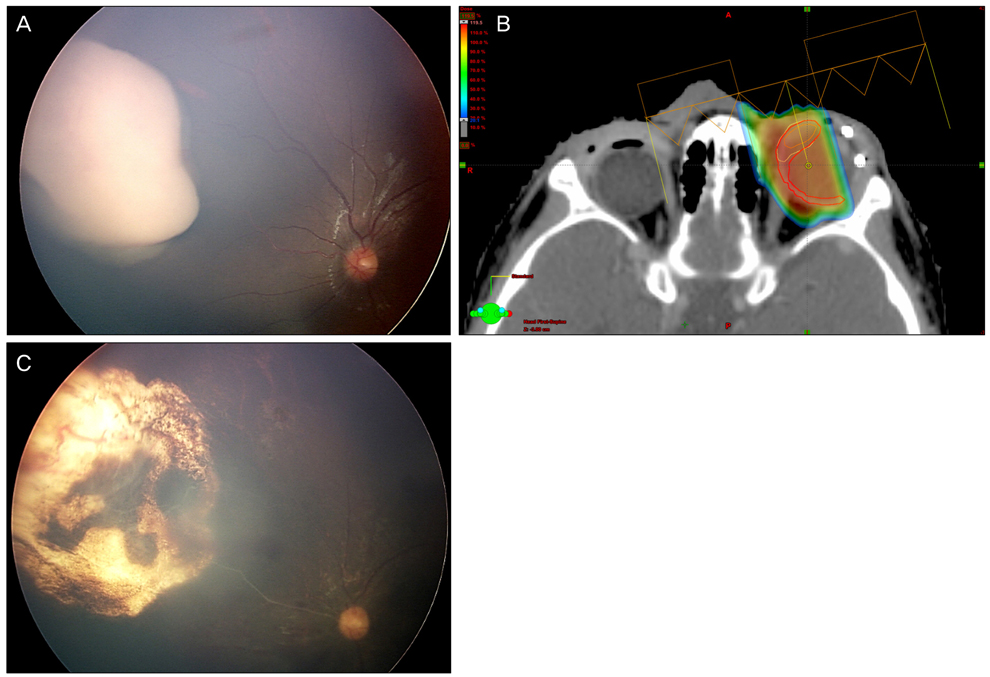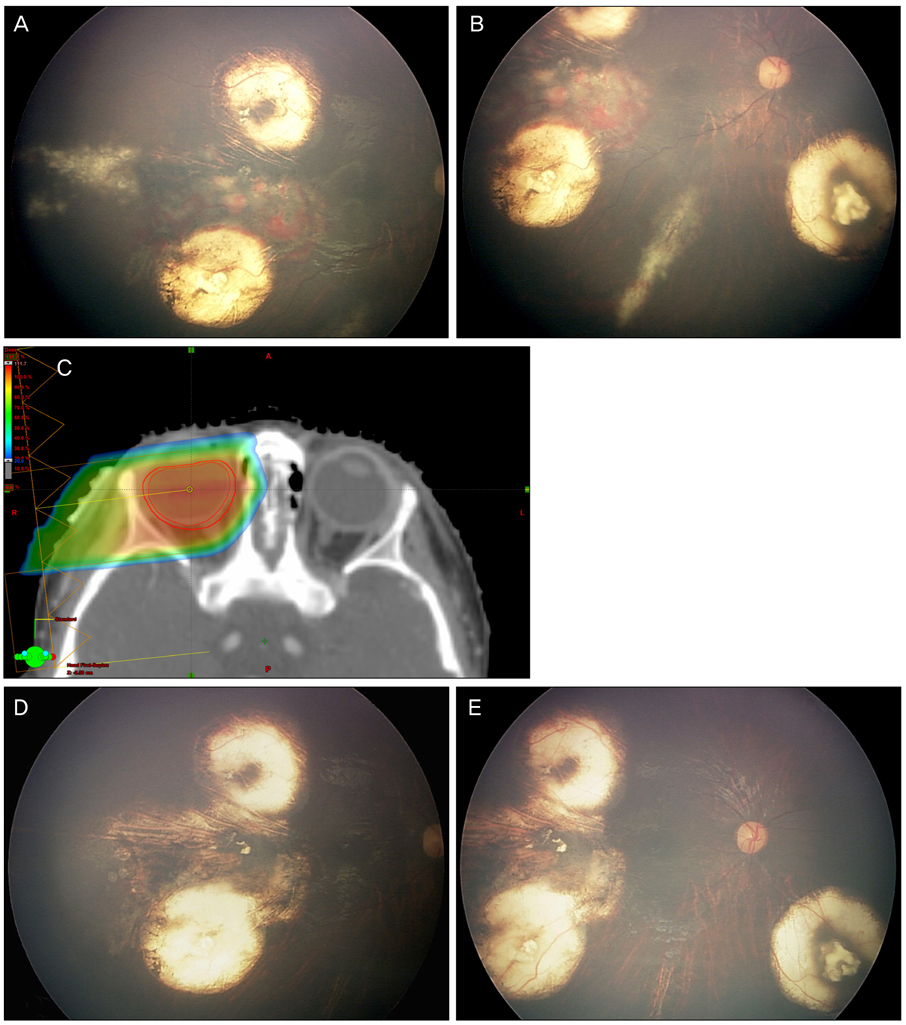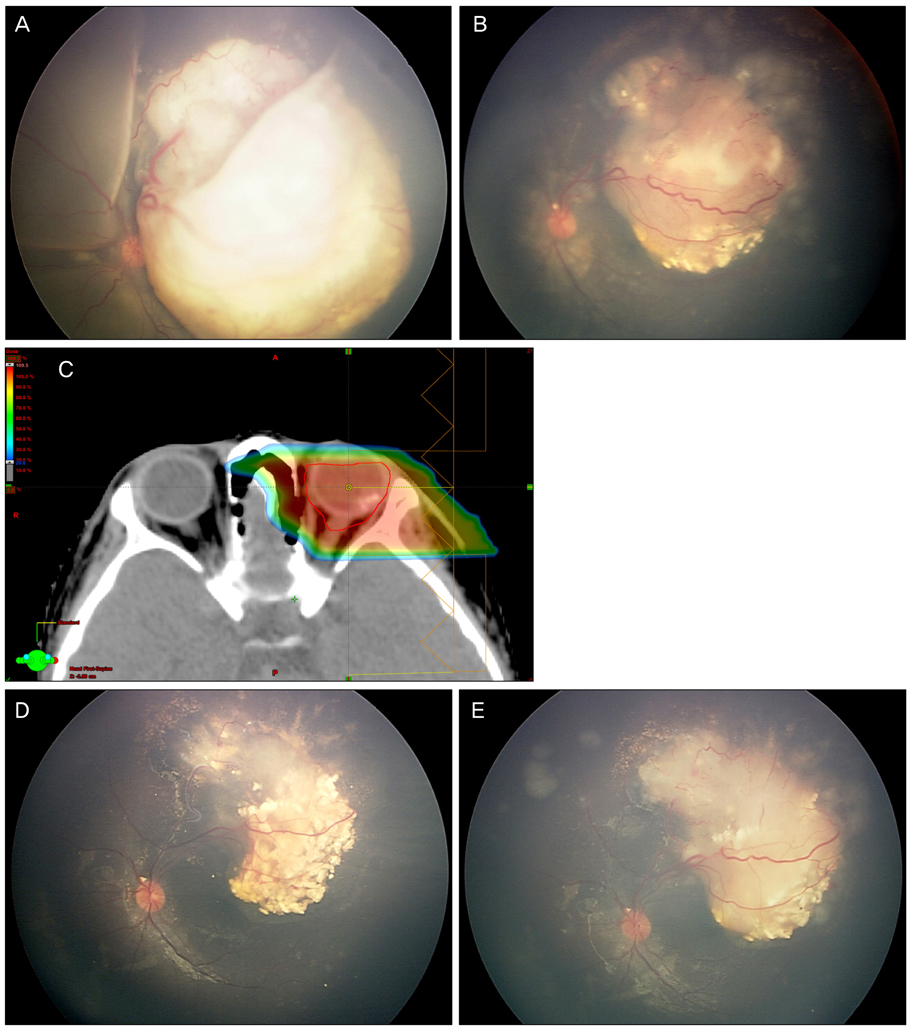Korean J Ophthalmol.
2011 Dec;25(6):387-393. 10.3341/kjo.2011.25.6.387.
The Clinical Outcomes of Proton Beam Radiation Therapy for Retinoblastomas That Were Resistant to Chemotherapy and Focal Treatment
- Affiliations
-
- 1Department of Ophthalmology, Inje University Ilsan Paik Hospital, Goyang, Korea.
- 2Department of Ophthalmology, Seoul National University Hospital, Seoul, Korea. ysyu@snu.ac.kr
- 3Seoul Artificial Eye Center, Seoul National University Hospital Clinical Research Institute, Seoul, Korea.
- 4Proton Therapy Center, Research Institute and Hospital, National Cancer Center, Goyang, Korea.
- KMID: 1031185
- DOI: http://doi.org/10.3341/kjo.2011.25.6.387
Abstract
- PURPOSE
To evaluate the clinical results of proton beam radiation therapy (PBRT) for treatment of retinoblastoma.
METHODS
Children with retinoblastoma who were treated with chemotherapy and focal treatment such as brachytherapy and thermotherapy but showed no response or developed recurrences later received PBRT. The PBRT strategy was designed to concentrate the radiation energy to the retinoblastoma and spare the surrounding healthy tissue or organs.
RESULTS
There were three patients who received PBRT. The first patient received PBRT because of an initial lack of tumor regression with chemotherapy and brachytherapy. This patient showed regression after PBRT. The second patient who developed recurrence of retinoblastoma as diffuse infiltrating subretinal seeding was taken PBRT. After complete regression, there was recurrence of tumor and the eye was enucleated. The third patient had unilateral extensively advanced retinoblastoma. Initial chemotherapy failed and tumor recurred. The tumor responded to PBRT and regressed significantly. However, the eye developed sudden multiple recurrences, so we had to perform enucleation.
CONCLUSIONS
PBRT for retinoblastoma was effective in cases of showing no response to other treatment modalities. However, it should be carefully applied when there was recurrence of diffuse infiltrating subretinal seeding or extensively advanced retinoblastoma initially.
Keyword
MeSH Terms
Figure
Cited by 3 articles
-
Effects on Periocular Tissues after Proton Beam Radiation Therapy for Intraocular Tumors
Youn Joo Choi, Tae Wan Kim, Suzy Kim, Hokyung Choung, Min Joung Lee, Namju Kim, Sang In Khwarg, Young Suk Yu
J Korean Med Sci. 2018;33(16):. doi: 10.3346/jkms.2018.33.e120.Proton therapy in pediatric brain tumors
Joo-Young Kim
J Korean Med Assoc. 2012;55(5):454-462. doi: 10.5124/jkma.2012.55.5.454.Proton therapy in pediatric brain tumors
Joo-Young Kim
J Korean Med Assoc. 2012;55(5):454-462. doi: 10.5124/jkma.2012.55.5.454.
Reference
-
1. Devesa SS. The incidence of retinoblastoma. Am J Ophthalmol. 1975. 80:263–265.2. Tamboli A, Podgor MJ, Horm JW. The incidence of retinoblastoma in the United States: 1974 through 1985. Arch Ophthalmol. 1990. 108:128–132.3. Verhoeff FH. Glioma retinae treated by X-rays, with apparent destruction of the tumor and preservation of normal vision. Trans Am Ophthalmol Soc. 1921. 19:209–216.4. Hilgartner HL. Report of case of double glioma treated with x-ray. 1903. Tex Med. 2005. 101:10.5. Wong FL, Boice JD Jr, Abramson DH, et al. Cancer incidence after retinoblastoma. Radiation dose and sarcoma risk. JAMA. 1997. 278:1262–1267.6. Mohney BG, Robertson DM, Schomberg PJ, Hodge DO. Second nonocular tumors in survivors of heritable retinoblastoma and prior radiation therapy. Am J Ophthalmol. 1998. 126:269–277.7. Smith LM, Donaldson SS, Egbert PR, et al. Aggressive management of second primary tumors in survivors of hereditary retinoblastoma. Int J Radiat Oncol Biol Phys. 1989. 17:499–505.8. Imhof SM, Mourits MP, Hofman P, et al. Quantification of orbital and mid-facial growth retardation after megavoltage external beam irradiation in children with retinoblastoma. Ophthalmology. 1996. 103:263–268.9. Kingston JE, Hungerford JL, Madreperla SA, Plowman PN. Results of combined chemotherapy and radiotherapy for advanced intraocular retinoblastoma. Arch Ophthalmol. 1996. 114:1339–1343.10. Shields CL, Shields JA, Needle M, et al. Combined chemoreduction and adjuvant treatment for intraocular retinoblastoma. Ophthalmology. 1997. 104:2101–2111.11. Lee CT, Bilton SD, Famiglietti RM, et al. Treatment planning with protons for pediatric retinoblastoma, medulloblastoma, and pelvic sarcoma: how do protons compare with other conformal techniques? Int J Radiat Oncol Biol Phys. 2005. 63:362–372.12. Krengli M, Hug EB, Adams JA, et al. Proton radiation therapy for retinoblastoma: comparison of various intraocular tumor locations and beam arrangements. Int J Radiat Oncol Biol Phys. 2005. 61:583–593.13. Munier FL, Verwey J, Pica A, et al. New developments in external beam radiotherapy for retinoblastoma: from lens to normal tissue-sparing techniques. Clin Experiment Ophthalmol. 2008. 36:78–89.14. Crowther JG. The cavendish laboratory 1874-1974. 1974. New York: Science History Publication;181.15. Debus J, Hug EB, Liebsch NJ, et al. Brainstem tolerance to conformal radiotherapy of skull base tumors. Int J Radiat Oncol Biol Phys. 1997. 39:967–975.16. Egger E, Schalenbourg A, Zografos L, et al. Maximizing local tumor control and survival after proton beam radiotherapy of uveal melanoma. Int J Radiat Oncol Biol Phys. 2001. 51:138–147.17. Bush DA, Slater JD, Bonnet R, et al. Proton-beam radiotherapy for early-stage lung cancer. Chest. 1999. 116:1313–1319.18. Croughs P, Deman C, Richard F, et al. Treatment of retinoblastoma using accelerated protons. Bull Soc Belge Ophtalmol. 1992. 243:81–85.19. Suit H. The Gray Lecture 2001: coming technical advances in radiation oncology. Int J Radiat Oncol Biol Phys. 2002. 53:798–809.20. Gunduz K, Shields CL, Shields JA, et al. The outcome of chemoreduction treatment in patients with Reese-Ellsworth group V retinoblastoma. Arch Ophthalmol. 1998. 116:1613–1617.21. Shields CL, Meadows AT, Shields JA, et al. Chemoreduction for retinoblastoma may prevent intracranial neuroblastic malignancy (trilateral retinoblastoma). Arch Ophthalmol. 2001. 119:1269–1272.22. Wilson MW, Rodriguez-Galindo C, Haik BG, et al. Multiagent chemotherapy as neoadjuvant treatment for multifocal intraocular retinoblastoma. Ophthalmology. 2001. 108:2106–2114.23. Shields CL, Honavar SG, Shields JA, et al. Factors predictive of recurrence of retinal tumors, vitreous seeds, and subretinal seeds following chemoreduction for retinoblastoma. Arch Ophthalmol. 2002. 120:460–464.24. Abramson DH, Beaverson KL, Chang ST, et al. Outcome following initial external beam radiotherapy in patients with Reese-Ellsworth group Vb retinoblastoma. Arch Ophthalmol. 2004. 122:1316–1323.25. Fontanesi J, Pratt CB, Kun LE, et al. Treatment outcome and dose-response relationship in infants younger than 1 year treated for retinoblastoma with primary irradiation. Med Pediatr Oncol. 1996. 26:297–304.
- Full Text Links
- Actions
-
Cited
- CITED
-
- Close
- Share
- Similar articles
-
- Recent Updates on Radiation Therapy for Pediatric Optic Pathway Glioma
- Proton Therapy Review: Proton Therapy from a Medical
- Radiation Therapy against Pediatric Malignant Central Nervous System Tumors : Embryonal Tumors and Proton Beam Therapy
- Treatment of Retinoblastoma: The Role of External Beam Radiotherapy
- A Pilot Study of the Scanning Beam Quality Assurance Using Machine Log Files in Proton Beam Therapy




